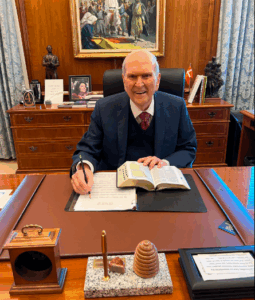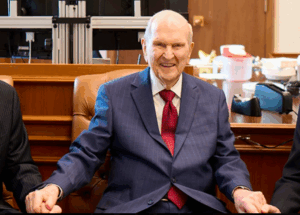A Century of Remarkable Service Comes to an End
Today lets talk about President Russell M. Nelson Biography: On September 27, 2025, the world lost a remarkable man who had touched millions of lives across two extraordinary careers. President Russell M. Nelson died at age 101, having served as the 17th President of The Church of Jesus Christ of Latter-day Saints since January 2018. His passing marks the end of a century-long life that encompassed groundbreaking achievements in cardiac surgery, decades of religious leadership, and a legacy of service that spanned the globe.
Known as a Renaissance man by his colleagues, President Nelson’s life represented the convergence of scientific excellence and spiritual devotion, demonstrating that faith and reason need not be opposing forces but can complement and strengthen each other.
President Russell M. Nelson Biography
President Russell M. Nelson Early Life: Born in Salt Lake City
Russell Marion Nelson was born on September 9, 1924, in Salt Lake City, Utah, to Marion Clavar Nelson (1897-1990) and Edna Floss Anderson (1893-1983). Growing up in Utah during the Great Depression, young Russell learned early the values of hard work, education, and faith that would define his entire life.
A native of Salt Lake City, Utah, Nelson attended the University of Utah for his undergraduate and medical school education, beginning a journey that would establish him as one of the pioneering figures in cardiac surgery. His early years in Salt Lake City provided him with deep roots in his community and faith tradition that would anchor him throughout his remarkable career.

President Russell M. Nelson Academic Excellence: A Prodigy in Medicine
Russell Nelson’s intellectual gifts became evident early in his academic career. He earned a bachelor of arts in basic biological sciences with high honors in 1945, and a doctor of medicine degree in 1947, at age 22. Graduating from medical school at such a young age was remarkable in itself, but doing so first in his University of Utah medical school class in August 1947 demonstrated exceptional brilliance.
His academic achievements earned him membership in honorary scholastic societies including Phi Beta Kappa and Alpha Omega Alpha, recognizing his outstanding scholarship in both liberal arts and medicine. These honors reflected not just his intellectual capabilities but also his dedication to excellence in everything he pursued.
President Russell M. Nelson Pioneering Cardiac Surgery
Dr. Nelson’s medical career coincided with one of the most revolutionary periods in medical history – the development of open-heart surgery. He was part of a research team that developed the heart-lung machine that made possible the first human open-heart surgery in 1951, contributing to medical advances that would save countless lives over the following decades.
In 1955 President Nelson performed the first open-heart surgery in Utah, marking a watershed moment in the state’s medical history. This achievement required not just technical skill but also courage and innovation, as open-heart surgery was still in its infancy and carried significant risks.
Throughout his medical career, he completed more than 7,000 operations, each one representing a life saved or improved through his skill and dedication. This extraordinary number of surgeries speaks to his commitment to his medical practice and his reputation as one of the world’s leading cardiac surgeons.
President Russell M. Nelson Military Service
Dr. Nelson spent two years as an Army medical officer during the Korean War, serving in Korea and putting his medical skills to use in service of his country during a time of conflict. This military service added another dimension to his life of service, demonstrating his willingness to serve in multiple capacities and under challenging circumstances.
President Russell M. Nelson International Medical Recognition
As an internationally renowned surgeon and medical researcher, Dr. Nelson’s reputation extended far beyond Utah or even the United States. His expertise in cardiac surgery made him a sought-after consultant and teacher, and his contributions to medical literature helped advance the entire field of cardiac care.
His medical career took him around the world, performing surgeries, teaching other surgeons, and advancing the cause of cardiac medicine globally. This international experience would later serve him well in his religious leadership role, as he understood diverse cultures and had already developed a global perspective.
President Russell M. Nelson Personal Life: Family and Marriage
On August 31, 1945, Russell Nelson married Dantzel White (1926-2005) in the Salt Lake Temple. Their marriage would last nearly 60 years and produce ten children – nine daughters and one son. Dantzel was his partner through his demanding medical career and his transition to religious leadership, providing the stable family foundation that supported all his achievements.
Sylvia Webster, one of President Nelson’s nine daughters, said her father accomplishes much because he knows how to balance his life. “When he’s at work, he’s 100% at work,” she observed, highlighting his ability to focus completely on whatever task was before him while maintaining family relationships.
Tragically, Dantzel passed away in 2005, ending their long marriage. However, on April 6, 2006, he married Wendy L Watson in the Salt Lake Temple, beginning a new chapter of companionship that would last nearly two decades and support him through his presidency of the Church.
President Russell M. Nelson Transition to Religious Leadership
In 1984, at age 59, Dr. Nelson made a dramatic career change when he was called to serve in the Quorum of the Twelve Apostles, one of the highest governing bodies of The Church of Jesus Christ of Latter-day Saints. He was selected in 1984 to join this top church governing body, marking his transition from full-time medical practice to full-time religious service.
This transition required him to step away from his successful medical career at its height to dedicate himself completely to Church service. The decision reflected his deep faith and his belief that religious service took precedence over personal career achievement, no matter how distinguished that career had been.
He served as a member of that quorum since April 7, 1984, spending 34 years in this role before ascending to the Church presidency. These decades in the Quorum of the Twelve provided him with extensive experience in Church governance and prepared him for the ultimate leadership responsibility he would assume in 2018.
President Russell M. Nelson Ascending to the Presidency
President Nelson was set apart as the 17th President of The Church of Jesus Christ of Latter-day Saints on January 14, 2018, following the death of President Thomas S. Monson. At age 93, he became one of the oldest individuals to assume leadership of the Church, and his presidency would prove to be remarkably active and transformative despite his advanced age.
His ascension to the presidency came after more than three decades of service in the Quorum of the Twelve Apostles, during which time he had traveled extensively, spoken to members worldwide, and developed a deep understanding of the global Church and its needs.
President Russell M. Nelson Presidency of Historic Changes
Despite assuming the presidency at an advanced age, President Nelson’s tenure was marked by significant changes and initiatives within the Church. He became known for his energetic leadership style and his willingness to implement changes he felt were inspired, including:
- Emphasizing the full name of the Church rather than shortened versions
- Adjusting meeting schedules to support family religious instruction
- Expanding missionary work and temple construction globally
- Using social media and modern technology to reach members
His presidency demonstrated that age need not be a barrier to vigorous leadership and that experience and wisdom can be paired with innovation and adaptability.
President Russell M. Nelson Historic Longevity
In 2024, President Nelson became the oldest-ever president of The Church of Jesus Christ of Latter-day Saints, surpassing all previous presidents in longevity. This historic milestone reflected both his remarkable health and vitality and the opportunity it provided for extended leadership during a critical period in the Church’s history.
His 101 years of life spanned more than a century of American and world history, from the 1920s through the 2020s, witnessing unprecedented technological, social, and cultural changes while maintaining his core values and faith commitments.
President Russell M. Nelson Global Travel and Outreach
Despite his advanced age, President Nelson maintained an active travel schedule, visiting members of the Church around the world. His international medical career had already given him comfort with global travel and diverse cultures, and as Church president, he continued to emphasize the worldwide nature of the faith.
His travels as president included visits to multiple continents, meeting with members, government leaders, and interfaith partners, always emphasizing messages of faith, hope, and service.
President Russell M. Nelson Legacy in Medicine
President Nelson’s contributions to cardiac surgery continue to impact medical practice today. The procedures and techniques he pioneered have been refined and built upon by subsequent generations of surgeons, but his foundational work helped establish the field that now saves hundreds of thousands of lives annually worldwide.
His example of combining rigorous scientific training with deep religious faith has inspired countless medical students and physicians who see no contradiction between scientific inquiry and spiritual devotion.
President Russell M. Nelson Legacy in Religious Leadership
As the 17th president of one of the world’s fastest-growing religious organizations, President Nelson’s impact on The Church of Jesus Christ of Latter-day Saints will be felt for generations. His emphasis on the Savior, his attention to doctrinal precision, and his implementation of inspired changes have shaped the Church’s direction into the 21st century.
Under his leadership, the Church continued its global expansion, with particular growth in Africa, Latin America, and Asia, while maintaining strong membership in traditional strongholds.
A Life of Balance
One of the most remarkable aspects of President Nelson’s life was his ability to excel in multiple demanding roles – as surgeon, researcher, religious leader, husband, and father to ten children. His daughter’s observation that he gave 100% to whatever he was doing captures the secret of his success: complete focus and dedication to the task at hand while maintaining appropriate balance across different life responsibilities.
President Russell M. Nelson Final Days and Passing
President Nelson died on September 27, 2025, at age 101, having lived a full century plus one year. His passing was mourned by members of The Church of Jesus Christ of Latter-day Saints worldwide and recognized by leaders across religious, medical, and civic communities as the loss of a remarkable man whose life embodied service, excellence, and faith.
The outpouring of tributes following his death reflected the breadth of his impact – from medical colleagues remembering his surgical pioneering to Church members grateful for his spiritual leadership to family members celebrating a beloved husband, father, and grandfather.

President Russell M. Nelson Century Well Lived
Russell M. Nelson’s 101 years encompassed two extraordinary careers, each of which would have been sufficient to mark a life well lived. His pioneering work in cardiac surgery saved thousands of lives and advanced medical science, while his decades of religious leadership touched millions of lives spiritually and organizationally.
His life demonstrated that excellence in secular pursuits and devotion to religious faith can not only coexist but can mutually reinforce each other. His scientific mind brought rigor and precision to his religious leadership, while his faith provided moral grounding and purpose to his medical work.
As the world reflects on his century of life, President Russell M. Nelson stands as an example of what dedication, talent, faith, and service can accomplish when combined in a single life devoted to blessing others.
Frequently Asked Questions About President Russell M. Nelson
When and where was President Nelson born, and what was his early life like?
Russell Marion Nelson was born on September 9, 1924, in Salt Lake City, Utah, to Marion Clavar Nelson and Edna Floss Anderson. He was a native of Salt Lake City who attended the University of Utah, earning his bachelor’s degree in basic biological sciences with high honors in 1945 and his medical degree in 1947 at age 22, graduating first in his medical school class.
What were his major medical achievements?
Dr. Nelson was part of a research team that developed the heart-lung machine enabling the first human open-heart surgery in 1951. In 1955, he performed the first open-heart surgery in Utah. Throughout his career, he completed more than 7,000 operations and became an internationally renowned cardiac surgeon and medical researcher. He also served two years as an Army medical officer during the Korean War.
When did he transition to religious leadership and what positions did he hold?
In 1984, at age 59, Dr. Nelson was called to serve in the Quorum of the Twelve Apostles, one of the highest governing bodies of The Church of Jesus Christ of Latter-day Saints. He served in that role for 34 years before being set apart as the 17th President of the Church on January 14, 2018, following the death of President Thomas S. Monson. He served as president until his death in 2025.
What was his family life like?
President Nelson married Dantzel White on August 31, 1945, in the Salt Lake Temple. They had ten children together – nine daughters and one son. Dantzel passed away in 2005 after nearly 60 years of marriage. On April 6, 2006, he married Wendy L Watson in the Salt Lake Temple. His daughter Sylvia Webster noted he accomplished much because he knew how to balance life, being “100% at work” when working.
When and how did President Nelson die, and what records did he set?
President Nelson died on September 27, 2025, at age 101. In 2024, he became the oldest-ever president of The Church of Jesus Christ of Latter-day Saints, surpassing all previous presidents in longevity. His 101 years of life spanned more than a century, from 1924 to 2025, and he remained remarkably active throughout his presidency despite his advanced age
When and how did President Nelson die, and what records did he set?
President Nelson died on September 27, 2025, at age 101. In 2024, he became the oldest-ever president of The Church of Jesus Christ of Latter-day Saints, surpassing all previous presidents in longevity. His 101 years of life spanned more than a century, from 1924 to 2025, and he remained remarkably active throughout his presidency despite his advanced age.
Conclusion
President Russell M. Nelson’s extraordinary life of 101 years represents one of the most remarkable combinations of scientific achievement and spiritual leadership in modern history. His journey from medical prodigy to pioneering cardiac surgeon to president of a global religious organization demonstrates that a life dedicated to service can take many forms and that excellence in one field can complement and strengthen work in another.
His medical contributions alone would have secured his place in history. Performing the first open-heart surgery in Utah, completing more than 7,000 operations, and contributing to the development of the heart-lung machine that made modern cardiac surgery possible – these achievements saved countless lives and advanced medical science in fundamental ways. Young medical students still study techniques he helped pioneer, and patients around the world benefit from procedures he helped develop.
Yet at the height of his medical career, he chose to step away from surgical practice to devote himself completely to religious service. This transition at age 59 represented remarkable faith and sacrifice – leaving a prestigious medical career to serve in Church leadership. This decision reflected his core belief that spiritual service took precedence over personal achievement, no matter how distinguished that achievement might be.
His 34 years in the Quorum of the Twelve Apostles and 7 years as Church president were marked by global travel, doctrinal teaching, and administrative leadership that shaped the direction of The Church of Jesus Christ of Latter-day Saints. Despite assuming the presidency at age 93, he proved to be a vigorous and transformative leader, implementing changes he felt were inspired while maintaining doctrinal foundations.
Perhaps most remarkably, throughout both careers, he maintained strong family relationships, fathering and raising ten children with his first wife Dantzel, and finding companionship again with Wendy following Dantzel’s death. His ability to balance demanding professional responsibilities with family life provides a model for others seeking to maintain proper priorities despite professional pressures.
His daughter’s observation that he gave 100% to whatever he was doing captures an essential truth about his success – complete focus and dedication to the present task while maintaining overall life balance. This discipline allowed him to excel as surgeon, religious leader, researcher, teacher, husband, and father without sacrificing any role for another.
Living to 101 gave President Nelson the opportunity to serve longer than any previous Church president, providing stability and experienced leadership during a period of significant growth and change for the global faith. His longevity became its own form of service, as members drew strength from his vitality and vigor even at advanced age.
His passing marks the end of an era – he was among the last Church leaders to have lived through World War II, the Depression, and the mid-20th century that shaped so much of modern Mormonism. His century of life witnessed unprecedented technological, social, and cultural changes, yet he maintained core values of faith, family, and service throughout.
President Russell M. Nelson’s life reminds us that greatness can be achieved in multiple fields, that faith and science need not conflict, and that a life dedicated to serving others – whether through medicine or ministry – is a life well lived.
Also Read: Zubeen Garg Biography
